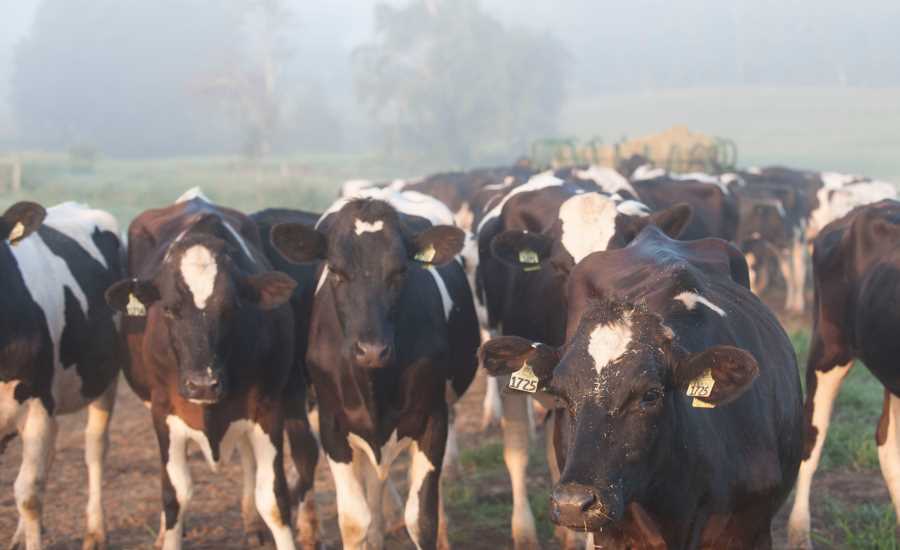Truth and consequences
Removing rBST from milk supply creates a ripple effect on supply, prices, environment
To produce the same amount of milk without rBST, Wisconsin farmers would need an additional 59,000 cows, 164,000 acres of cropland and 23.9 billion gallons of water.

By Prof. Michael Hutjens, University of Illinois
Recently, Wisconsin dairy farmers received a notice that they could not use rBST in their dairy herds starting in January 2017. Let’s look at this decision from different perspectives: dairy farmers, milk processors, consumers and the environment.
An explanation of the BST and rBST hormones
All milk contains BST (bovine somatropin), a hormone found in nature that impacts numerous biological processes in the lactating cow (for example, energy metabolism, growth and milk production). Somatropin is also found in human milk and other species. The letter “r” in rBST indicates “recombinant” and that this hormone was biosynthesized by bacterial fermentation.
After the protein is produced it is purified, formulated into a product that can be injected in cows, leading to approximately 10 pounds more milk per cow. The rBST must be injected as it is a protein-based hormone (similar to human insulin) and is degraded when digested to amino acids if consumed orally, It has no biological effect on humans if injected directly and does not change the composition of the milk produced by cows. No lab test can detect if a cow or herd was injected with rBST. The rBST is injected starting after nine to 10 weeks after calving (label directions approved by FDA).
A dramatic drop in milk production when rBST is removed
The immediate impact when rBST is removed will be a drop in milk yield from 8 to over 20 pounds, depending on the lactation phase of the cow. Contingent on feed costs, rBST cost, milk price and labor charges, the drop in profit can vary from 60 cents to $1.50 per cow per day.
With the low milk prices in 2016 and projected milk prices in 2017, this decline in profit can be the difference between break-even and staying in the dairy business. When the University of Illinois Dairy Farm was forced to remove rBST, we saw the following:
• Cows over 100 days in milk dropped 8 to 10 pounds of milk per cow per day
• Cows over 200 days in milk dropped 15 to 20 pounds of milk per cow per day
• Cows over 300 days in milk stopped milk (dried off or dropped over 25 to 30 pounds per cow per day)
Dairy farmers will need to respond to this issue (rBST removal) and future issues (using new technology and innovation) that may potentially impact their management systems, sustainability and profits. GMO feed, antibiotics, tail-docking, gene mapping and some breeding practices are all potential technology targets going forward.
Consumers could pay more for rBST-free milk
Consumers have a role in the decision not to allow rBST use, as well. With lower milk yield per cow, milk and dairy product prices would logically increase. The good news is consumers have multiple/numerous milk and dairy product choices when they go to the dairy case to get this important source of quality protein.
One key question to consider is, if 5% of the purchased milk in the U.S. is organic, does this force the remaining 95% to be denied the right to “green” milk and future technologies that will be developed? “Green” milk is produced using available technologies approved by the FDA and adopted by dairy farmers (their choice) that help make milk production more sustainable for the environment.
Impact on milk processors and retailers
Milk processors and retail stores sell dairy products to make money. Milk cooperatives are in the same business to make money for their dairy farmer owners. Marketing is the name of the game. When a change in technology or application occurs, the milk processor either adds it (such as vitamin D) or not. It may allow them to capture a larger percent of the dairy market share. Will these milk processors pay dairy farmers for their lost profit potential? While rBST is the current “hot technology target,” the future can bring additional marketing changes and challenges dictated by companies such as Wal-Mart, Ben and Jerry’s and Mc Donald’s.
Without rBST, farmers need more cows, cropland, water
One big concern is the resulting environmental impact of not allowing the use of rBST technology. To produce the same amount of milk without rBST, Wisconsin farmers would need an additional 59,000 cows (half the cows in Illinois), 164,000 acres of cropland – which is 257 square miles (the land area of Chicago) and 23.9 billion gallons of water (more than the annual water usage of 43,000 U.S. households with four individuals).
These additional cows would add 733,000 metric tons of carbon dioxide (equal to 155,000 cars on the road annually) and 15 metric tons of manure (annual human sewage of Missouri).
Because of technologies like rBST, “green” milk has the lowest carbon foot print of all milk produced which is a win for consumers, dairy farmers and milk processors.
Michael Hutjens is professor of animal sciences emeritus at the University of Illinois, Urbana.
